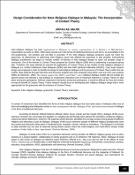Options
Design Consideration for Inter-Religious Dialogue in Malaysia: The Incorporation of Contact Theory
Date Issued
2019
Author(s)
Arfah Ab. Majid
Abstract
Inter-religious dialogue has been implemented in Malaysia by various organizations, be it Muslim’s or Non-Muslim’s organizations as early as 1950s. Often being carried out in the format of intellectual discourse and forum, its accessibility to the non-academician, non-scholars and non-elite is uncertain. If the inter-religious dialogue programs could not reach the grassroots, its effectiveness in addressing inter-religious issues that affected the grassroots is also doubtful. International dialogue practitioners has begun to include number of theories in their dialogue designs to reach out broader range of community. One of the theories is Contact Theory proposed by Gordon Allport (1959) aims at addressing in-group/out-group bias. Therefore, this study attempts to examine the application of Contact Theory in two models of inter-religious dialogue in Malaysia (i.e. Institut Kefahaman Islam Malaysia (IKIM) and Inter-faith Spiritual Fellowship (INSaF)). Case study research design was employed in order to identify the design of interreligious dialogue and the presence of Contact Theory within the two models. Data obtained through interviews and document analysis were than analysed using within-case and cross-case analysis (Miles & Huberman, 1994). The finding suggest that IKIM’s and INSaF’s inter-religious dialogue models did not include any special session that allowed a real dialogue or cooperative interaction (one of important elements in Contact Theory) to take place among the participants. Without cooperative interaction among the participants, it would be difficult for these two models to reap the benefit of Contact Theory. Future research should focus on developing inter-religious dialogue design that is more appropriate for the grassroots with the inclusion of Contact Theory.
Subjects
File(s)
Loading...
Name
Design Consideration For Inter-Religious Dialogue in Malaysia_ The Incorporatation of Contract Theory.pdf
Size
381.55 KB
Format
Adobe PDF
Checksum
(MD5):3e4e5ded4a1f0cd2f9fda3a4c8b31a63